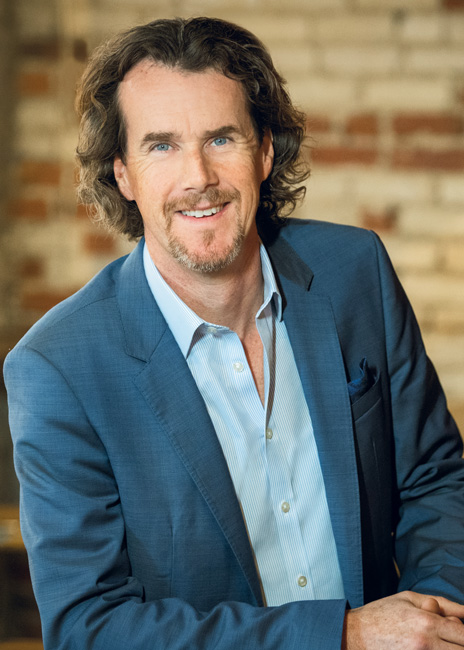From escalating operating costs to shifting consumer preferences to a rapidly evolving technology landscape, the challenges of today’s foodservice operators are real and many.
Challenges such as these require real solutions based on thoughtful design, equipment selection and more. Here, a trio of well-decorated foodservice consultants weigh in on a variety of issues facing the industry and the role equipment and design can play in resolving them.

Ed Doyle
President
RealFood Hospitality, Strategy & Design
With more than 35 years of hospitality experience, Ed Doyle has worked in some of the finest kitchens and foodservice operations across the industry.
Today, RealFood is part of the Troon family of brands and is positioned as a hospitality strategy and design firm, helping clients to define, design and deliver unique and memorable hospitality experiences.
Doyle also serves as the senior vice president of the Troon Food and Beverage division.

Khaled Halabi
Director of Design
Cini-Little International Inc.
Khaled Halabi excels in foodservice concept development and facility design. He has global experience in various market segments, most notably hospitality.
As director of design, he is responsible for Cini-Little’s Northeast and Central U.S regions, and the Canadian region. Halabi encourages designers to integrate emerging technologies with existing ones to deliver a tailored approach to design. He is a senior associate member of Foodservice Consultants Society International (FCSI).

Karen Malody, FCSI, MSW
Founder and Principal
Karen Malody founded Culinary Options in 1997 after departing Starbucks where she had been director of food, beverage and menu development. Prior to that time, she had been vice president of food, beverage and product development for Larry’s Markets, an upscale multiunit supermarket in Seattle.
Malody has received the Award for Excellence in Management Advisory Services from the Foodservice Consultants Society International. She also received the FE&S Top Achiever — Consultant award.
How have customer expectations evolved in recent years?
KM: Two terms come to mind: value perception and experience. With the financial sensitivity that many of us feel these days, the desire to make sure we get value for our money is really coming to the fore. But what creates a sense of value? In the old days, it had a lot to do with price and portion. In other words, “Am I getting a lot of food for the price point on the menu?” Now providing value is a bit more complicated in that it bleeds into the desire to have an experience.
For many owners/managers, having an experience means it includes theatrics of some sort. For me, providing an experience means getting back to the basics. It’s cleanliness. Knowledgeable servers. Speed of service. Staff being friendly and happy to see me. Experience, to me, means doing the right things at the right time for people. Never has there been more of a need for that. People just want to be appreciated and acknowledged, and they want to be together. So, we need to find the recipe for getting the basics right. Answer the customer’s questions. Be kind and alert. It’s so fundamental.
Real estate costs and utility costs continue to rise. How does this impact design and equipment choices? Is value engineering becoming more prominent?
KH: We are seeing an increase in a phased contractual approach to design. Projects, rather than going through the design process under one continuous contract, are now split up with each phase being approved independently and verified that it is within budget.
This may sound like the way things have always been done; however, much more importance is given to reviewing the design in each phase before proceeding with a lot of instances where each phase is a separate contract.
It seems that this process stems from the need to stick to budget more than any other time in the past and also potentially to confirm financing throughout the process so there are no surprises that either the budget is missed, or financing isn’t available or both.
We see ourselves being engaged more frequently on projects for the concept design phase only and then are called back for engagement for SD [schematic design] and so forth. VE [value engineering] is also becoming more critical to the process, and more time is spent at the end of each design phase to allow for any modifications that would provide savings on the capital investment or the operational costs of different pieces of equipment.
Distributed dining (or satellite dining) seems to be on the rise across a variety of operator segments. Is that something you are seeing?
ED: The consumer is consuming food and beverages in places and ways that we would have never anticipated a few short years ago. That, combined with the staffing challenges in the hospitality industry that will continue to endure, leads us to a hub-and-spoke model where we can centralize our talent and resources.
Are you seeing smaller footprints?
KH: Absolutely. I think this is the case in many B&I projects due to the change in trend from big cafes with sprawling servery and multiple stations to multiple offerings split up throughout the whole project on multiple floors and zones. A few factors led us to that change with some being social, some financial and some due to hybrid working systems.
Increased real estate costs drive this as does the labor shortage so we are finding ourselves innovating in design and equipment selection to provide a more versatile space within a smaller footprint that has multiple offerings and applications. Dispensing equipment, for example, offers multiple choices from a single tap; another example is cashless operations which reduce the footprint that would otherwise be needed for checkouts while also reducing the need for labor.
ED: Yes, but not as often as we should be. Unfortunately, legacy design continues to be the practice, failing to understand that thoughtful, intentional design doesn’t have a size limitation. Smarter equipment, smaller spaces, and smaller staffs can all deliver better financial outcomes without compromising the guest
experience or operational capabilities.
Equipment costs have increased in the past couple of years. How is this influencing budget, equipment selection and other factors?
ED: Ensuring that designers have a deep understanding of operations is critical to modeling the return on any capital investment. Our role in advocating for both the guest and staff experience and our client’s business strategy needs to be a key part of design and specification. Being able to explore both the qualitative and quantitative return of our specifications enables us to identify ways our clients can hedge against escalating equipment and development costs.
We talked about how customers’ expectations have evolved. What about foodservice management? How has what they are asking of operators and staff changed?
KM: Management is really asking leadership in the back of the house to be especially attentive to waste and
to make sure there’s intelligent cross-utilization of ingredients so the operator is not inventorying unnecessary items. This includes proper ordering to reduce pre-consumer waste, organization of walk-ins and other back-of-house areas to create efficiency — just being more organized because a lack of organization leads to more waste.
Operators are also managing menus to make sure they do not require more labor. In the front of the house, management is really focusing on taking care of the guest. They want staff to create a memorable experience by being knowledgeable and acknowledging the guest. You have to exhibit a genuine sense of hospitality. And that includes really understanding the menu and being able to explain things when questions arise.
Labor is such a challenge not only for operators but everyone in the foodservice industry. What advice do you have when it comes to retaining employees?
KM: Trying to get an employee to love what they do and stay means shifting your culture to be more appreciative, education oriented and values based. You appreciate what’s important to the team, and how you reward your people should match their values. You really need to encourage the issue of empowerment. You want the people who are on your team to know how they present themselves matters to the business. This is more important than ever. And employees won’t tolerate bad behavior on the part of management any longer. They won’t tolerate chaos or bad behavior. We’ve had enough turnover issues in our industry before now, and this only adds to it.
What are a few trends that excite you?
KH: Arena concessions are getting a lot of attention in an effort to minimize transaction times. We are seeing a lot of cashless trends in arenas from “just walk out” markets to cashless beer walls, providing a much faster transaction that allows for increased revenue while reducing wait times for customers. Many benefits come from this kind of automation: shorter wait times, faster transaction time, more product being sold, more revenue, increased customer satisfaction and customers who are more inclined to make multiple trips to concessions knowing that it’s a fast interaction and they won’t miss the show.
ED: Human-centric design where the employee experience is valued as much as the guest experience. It’s windows in the kitchen, it’s space for a place to sit down and take a break instead of eating over a trash can, it’s understanding that money spent on your staff is money well spent.
As the industry seeks to find solutions to our ongoing staffing crisis, we need to ensure that design and technology supports the success of nontraditional and less experienced workers, and as we source solutions that streamline training, as well as integrated intelligence that delivers more consistent results. Those are interesting to me.
KM: Most of the trends that excite me have to do with equipment choices and the back of the house. Clever use of speed-cook ovens excites me. This equipment is still underutilized. Ventless solutions are really exciting. The fact that additional capacity can be added to the back of the house without expensive hood space is really impactful. Locations that might not have allowed there to be any hot food at all can now do so. Coffee bars are a classic example. Their primary offerings don’t require venting, and now they can offer food at a relatively low entry point spatially and financially. Reducing menu sizes, smaller kitchens with use of multifunctional equipment.
Any foodservice equipment developments that excite you?
KH: I am interested to see where the market goes with induction cooking lines. So far, we have seen advancements with some manufacturers making more streamlined cookline designs with all induction units, but I think soon we will see a lot more manufacturers innovating on that front. Many brands have very solid offerings in the European market, and I think that with the electrification drive, it only makes sense it will become more common in the United States soon.
Want to hear more?
Ask these consultants a few questions of your own by registering for the companion webcast that will take place at 1 p.m. CST on Thurs., June 20. During this hour-long chat, these three consultants will take a deeper dive into such topics as automation and robotics, the electrification of commercial kitchens, the state of the supply chain and much more.



